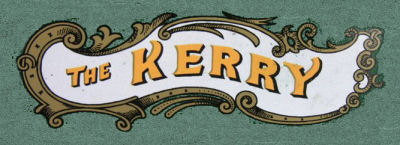

Kerry motorcycles were produced from 1902 to 1915, and again from 1960 to 1967.
In the early days these machines were sold by the East London Rubber Co, of Shoreditch. They were built by Sarolea and fitted with Belgian CIE (Pieper) and FN engines, in a loop frame with curved downtube. As a high-built primitive, it had belt drive and braced forks. Engines were of different sizes and there was also a ladies' model.
Kerry also produced sidecars from 1905 or earlier. In 1914 they offered 15 sidecar models.
Report from the 1902 Stanley Show
Motor Cycling, 26th November 1902
Reports from the 1903 Stanley Show:
The East London Rubber Co.
This firm's speciality at the Stanley Show will be Kerry motor bicycles in 2¼, 2¾, and 3½ h.p. A special point will be made of engine sets and motor cycle sets for agents, so that they may build machines themselves. The Kerry engine this year will be set vertical in a curved tube frame, but if preferred the engine sets and motor cycle sets can be supplied with the engine set into a loop frame.
A full range of all motor tyres, fittings, and accessories will also be found at this stand.
The Motor Cycle, November 18th 1903
Stanley Show 1903
The East London Rubber Co.
are exhibiting a large assortment of Kerry motor bicycles fitted with the Empire support. The engine is now brought absolutely vertical, and is improved in many details, including an improved silencer. A choice of three powers is given — 2¼ h.p. 2¾, h.p. and 3½ h.p. — the largest of these being fitted to a forecar. A lady's machine is shown to which is fitted a front wheel stand, the stays of which form the stays of the front mudguard. (Stand 144)
The Motor Cycle, November 25th 1903
Stanley Show 1903
1906 onwards. After the death of Alfred Kerry the parent company, East India Rubber, was acquired by Abingdon and the firm added V-twins to the range. Soon, using those engines, they were sold as the Kerry-Abingdon, and models included those fitted with a 3hp single and a 6hp V-twin. It is unclear when the ties with Sarolea were broken, if at all they were before production ceased after the outbreak of war.
1915 Having continued in the same vein for some years, due to the war production halted in December 1915. Post-war, they continued to build sidecars.
Many Sidecars.
East London Rubber Co., Ltd., 29, Great Eastern Street, London, E.C.2.
Quite apart from the rest of the sidecars (up among the accessories in the Gallery) are shown two of a very complete range offered by the East London Rubber Co., Ltd. The "Kerry" No. 7 pattern is distinguished by its superior finish, both of coachwork and upholstery. A good-sized locker, broad enough at the top to accommodate a fairly large suitcase, is provided. An enclosed wheel underslung type of chassis accommodates this body, the price complete being £23 10s.
The other sidecar shown is known as the Tourist No. 9, and is a roomy, well-upholstered model with an extremely well padded back cushion. Another very desirable feature, none too common on any of the sidecars exhibited at Olympia, is an unusually high back to the seat. This model is listed at £22 15s.
Olympia Show 1922, The Motor Cycle November 30th 1922, pp. 866-867
1960-1967 The name reappeared on a range of imported mopeds. These were sold as the Kerry Capitano.
Source: Graces Guide